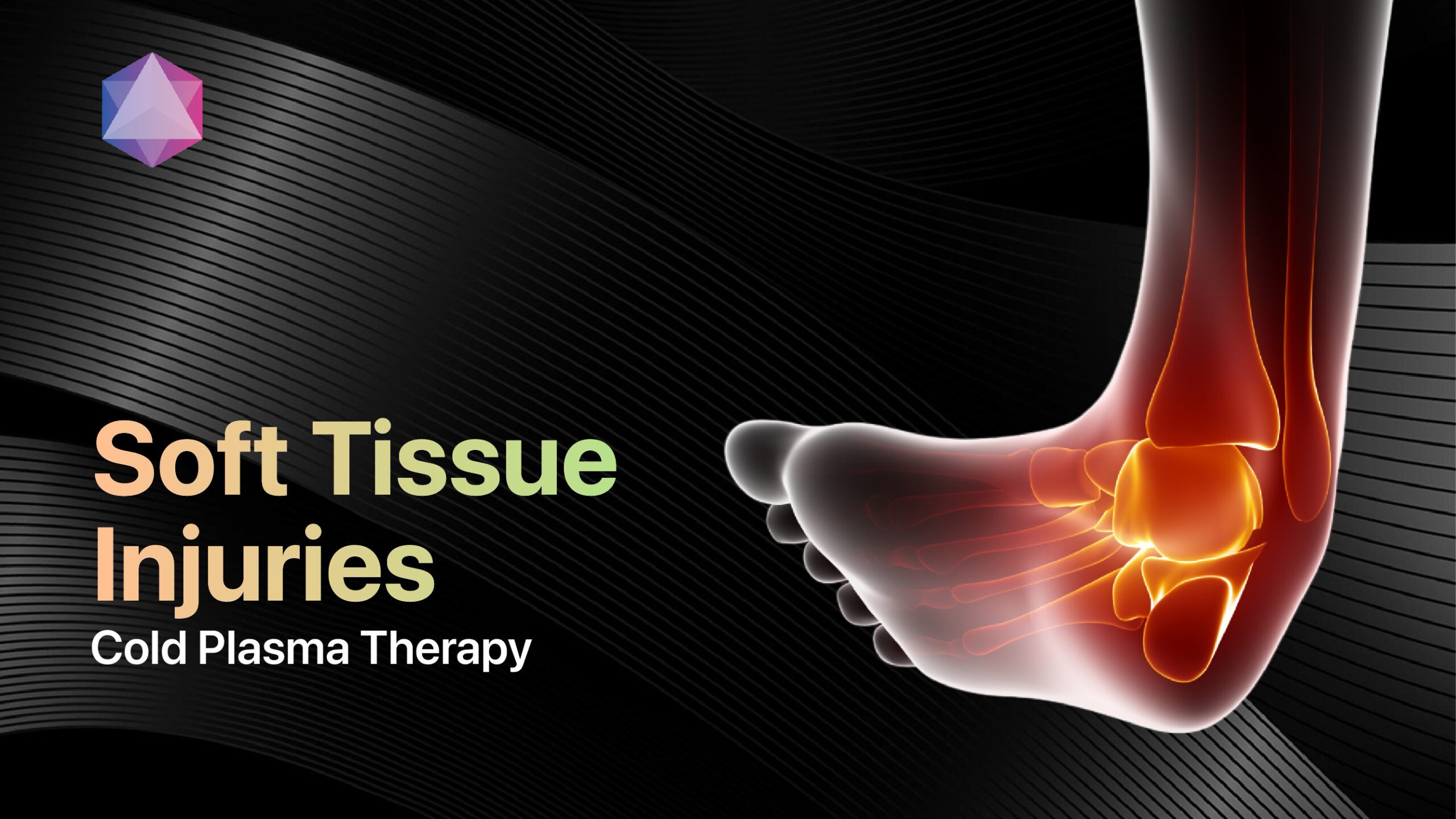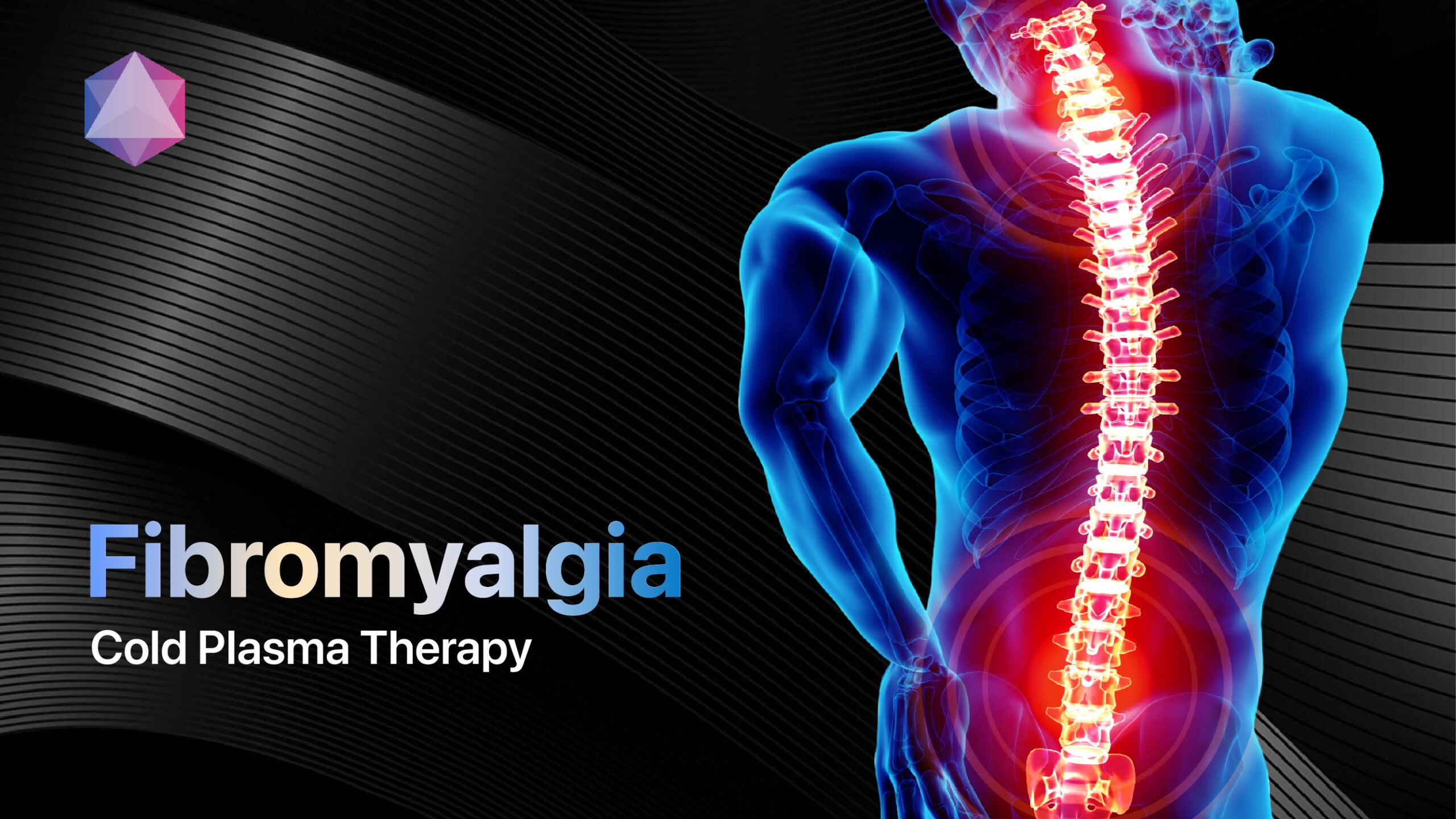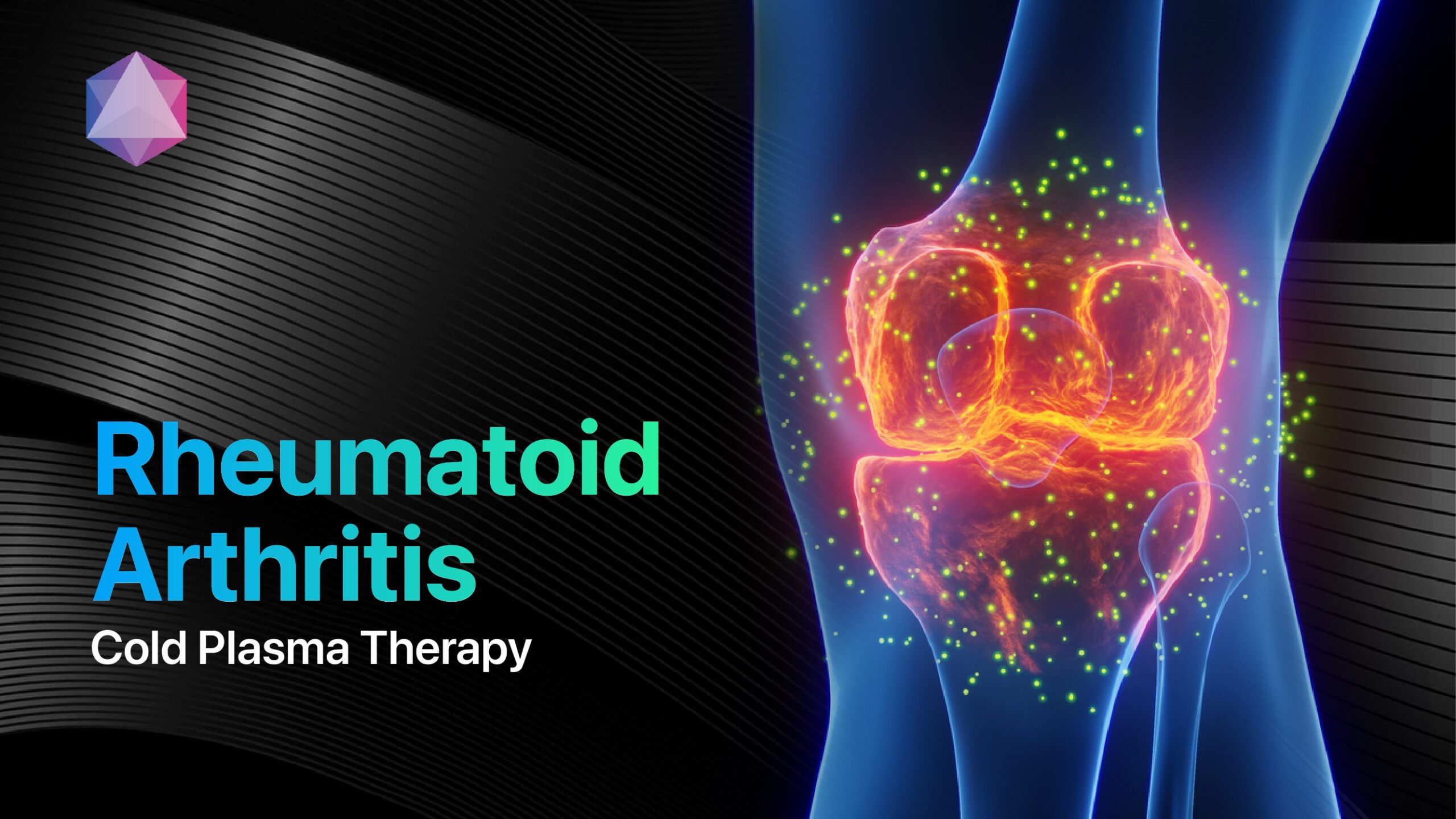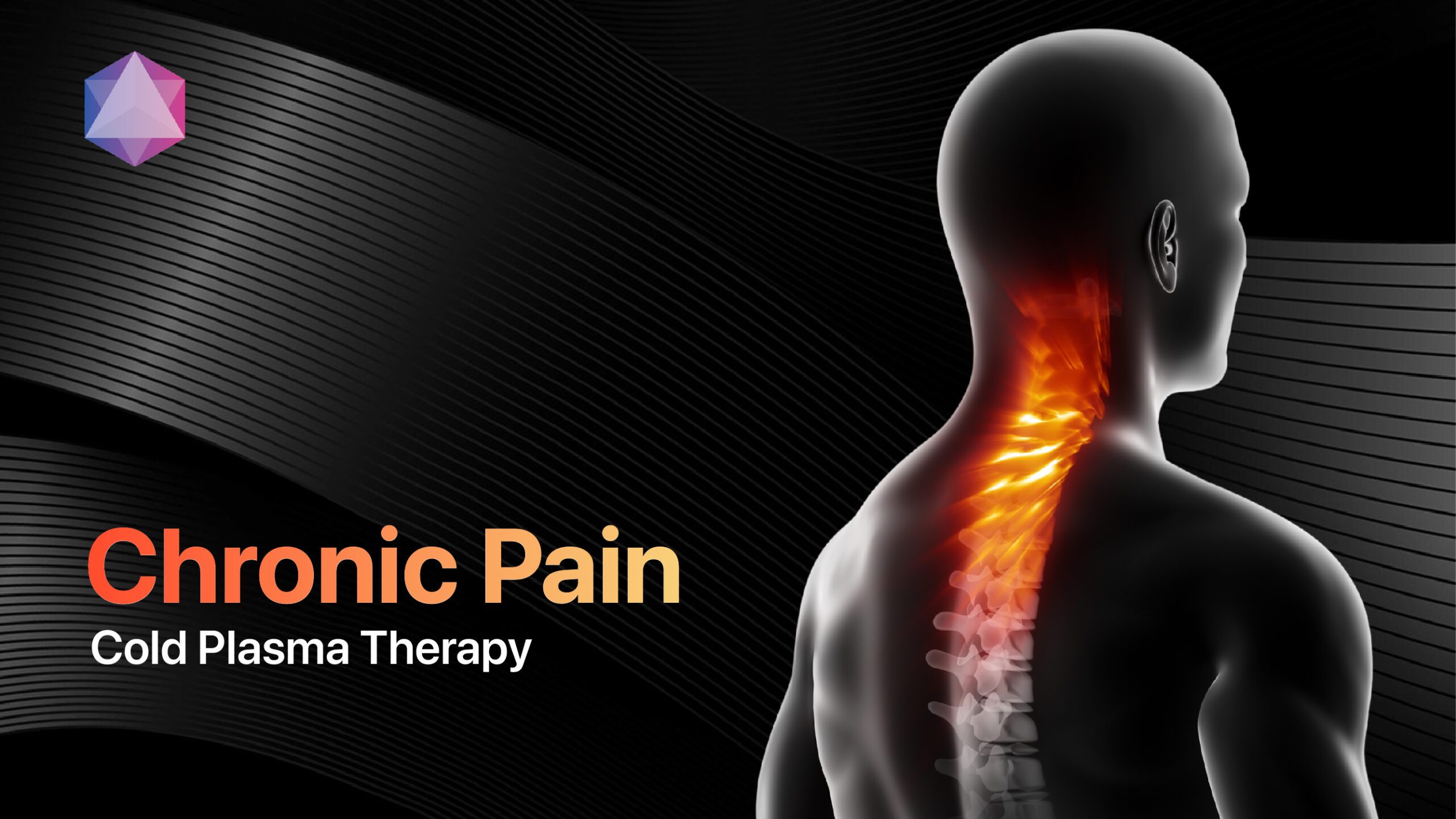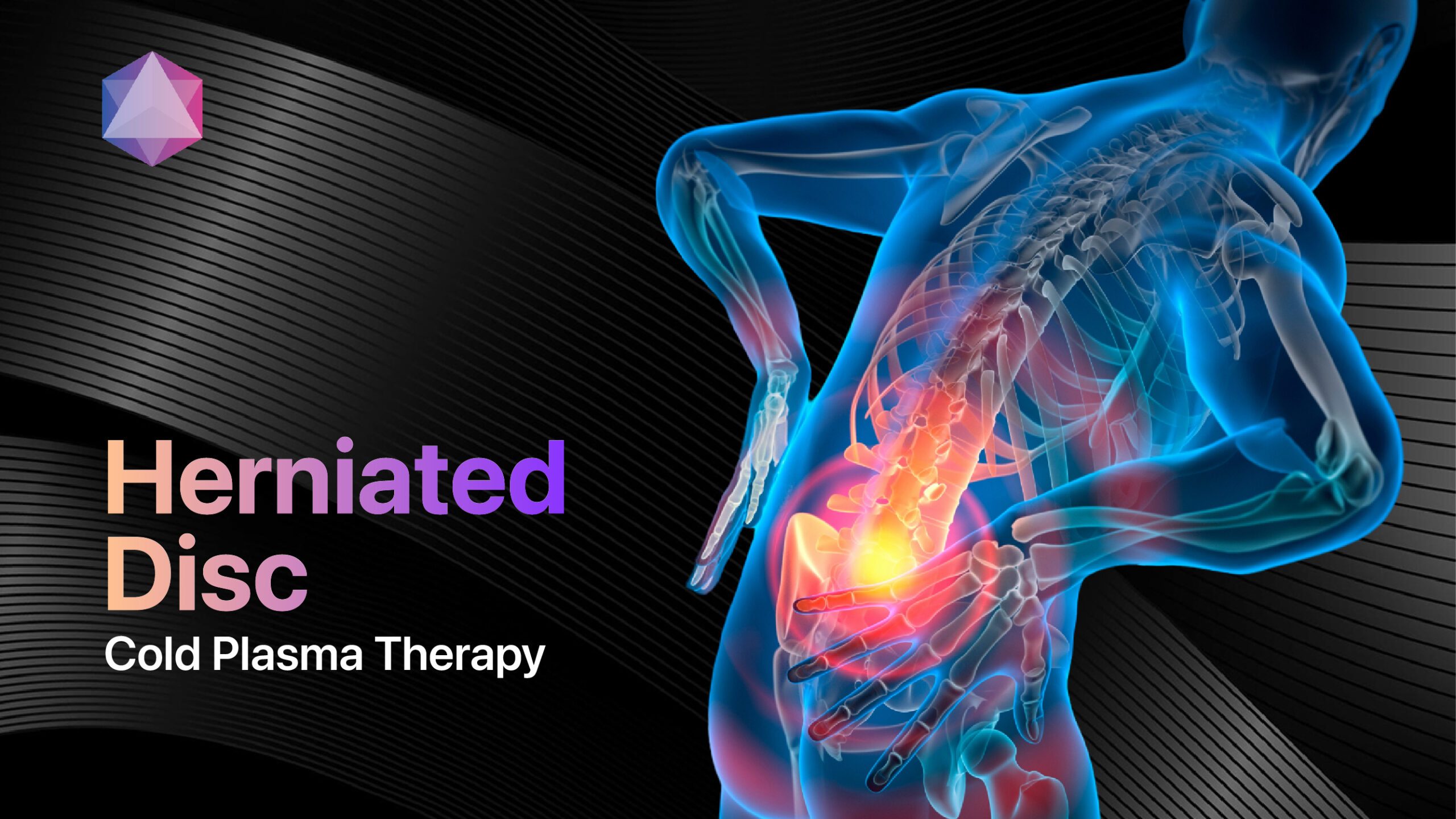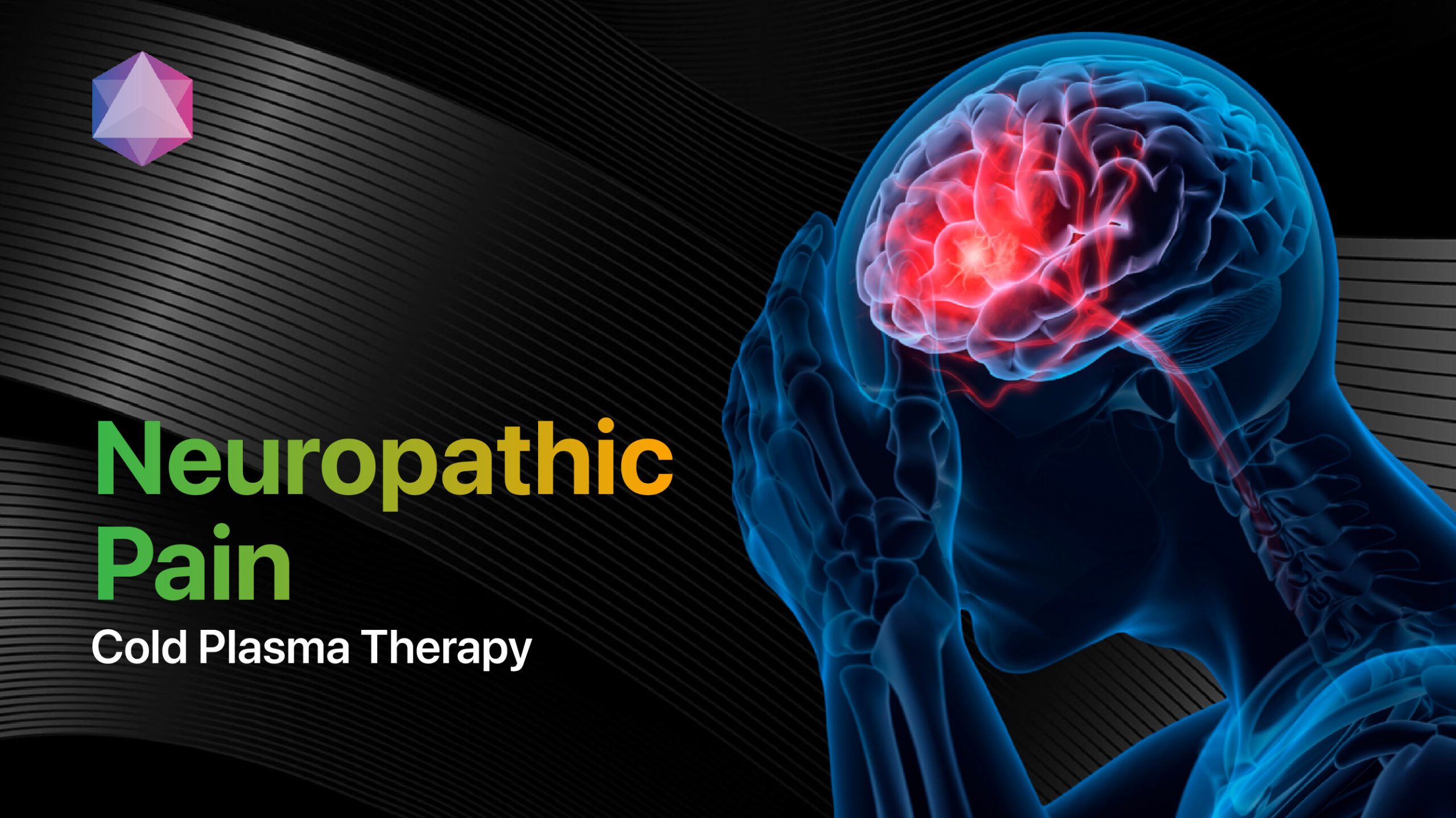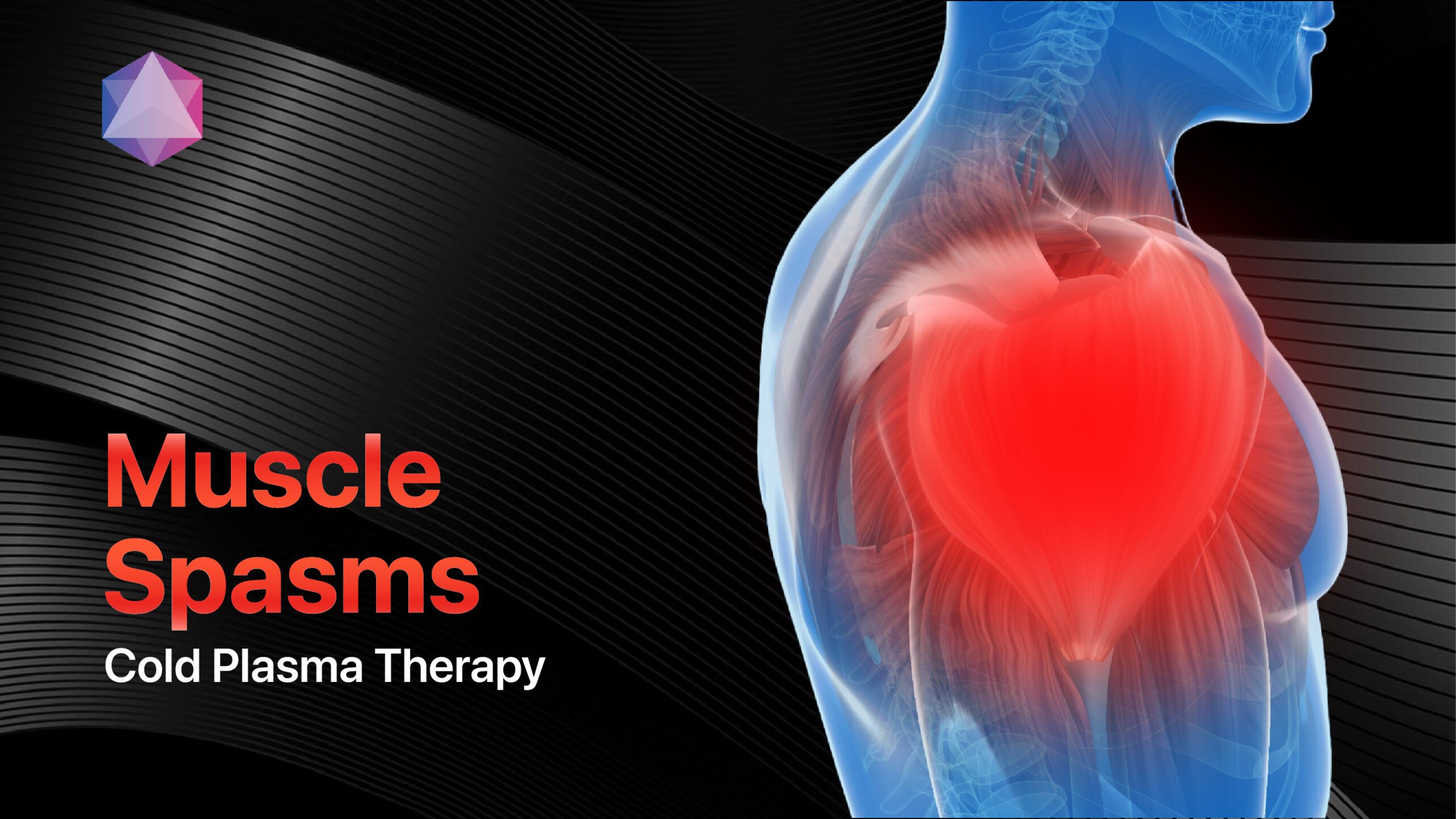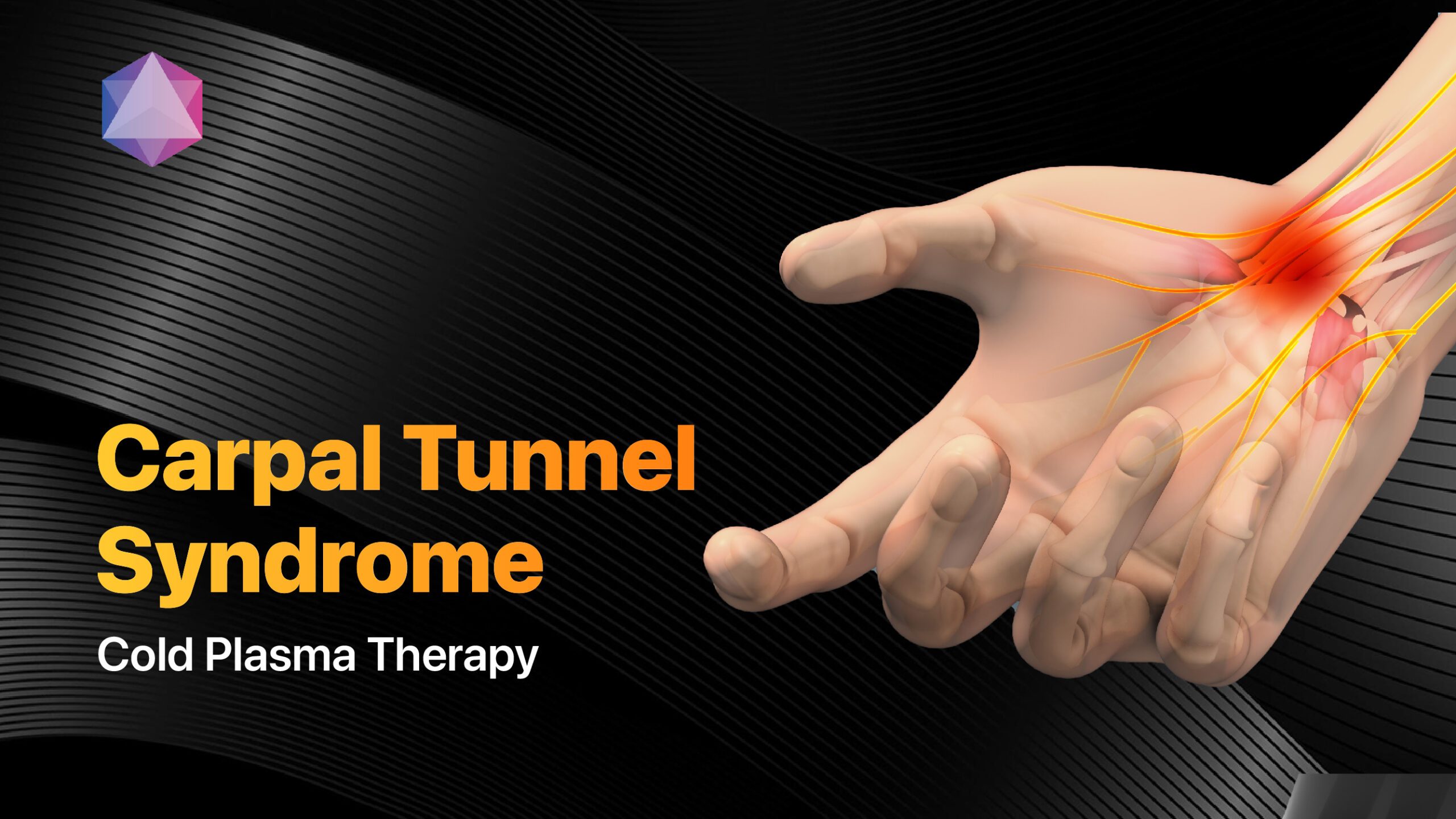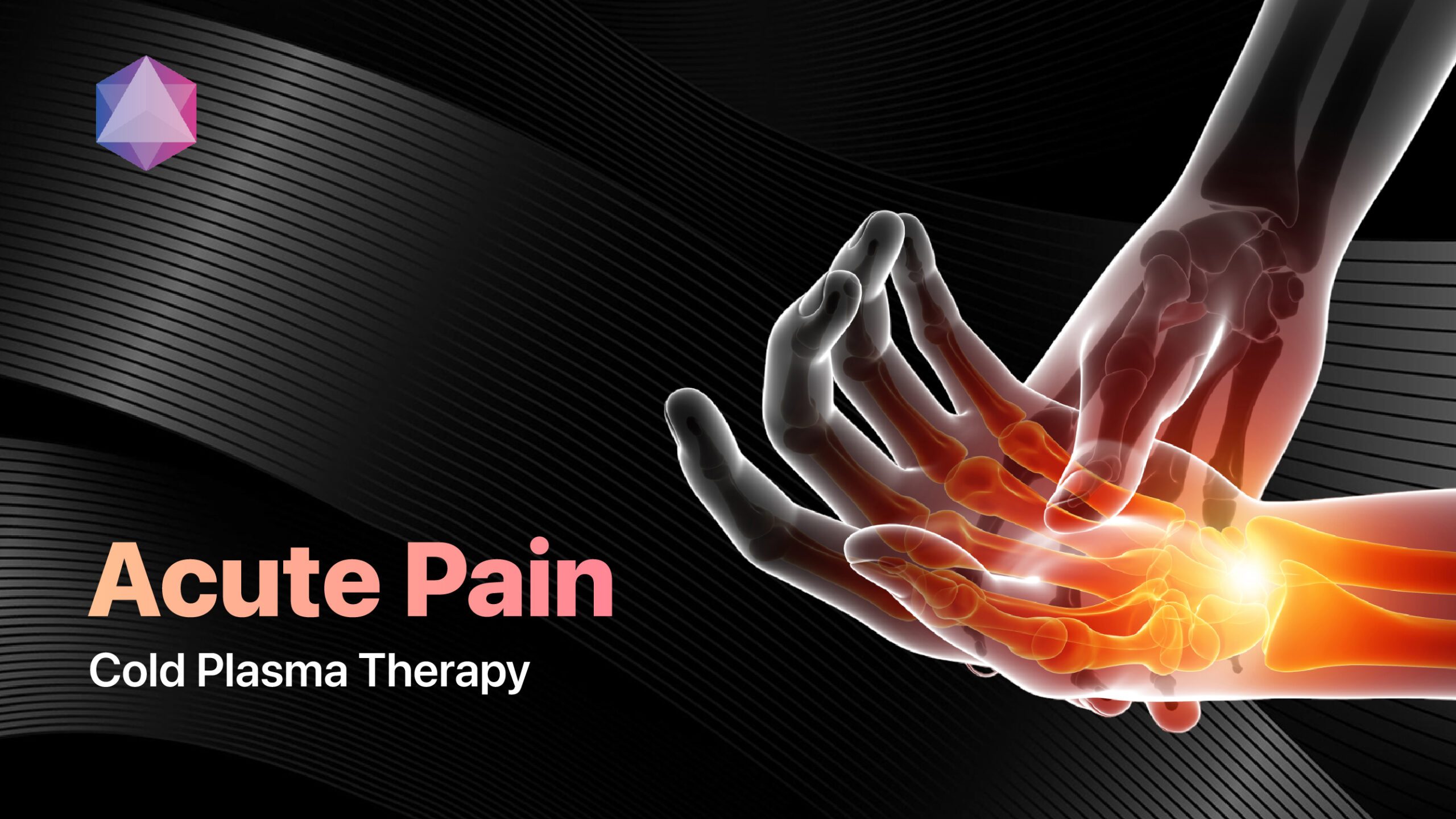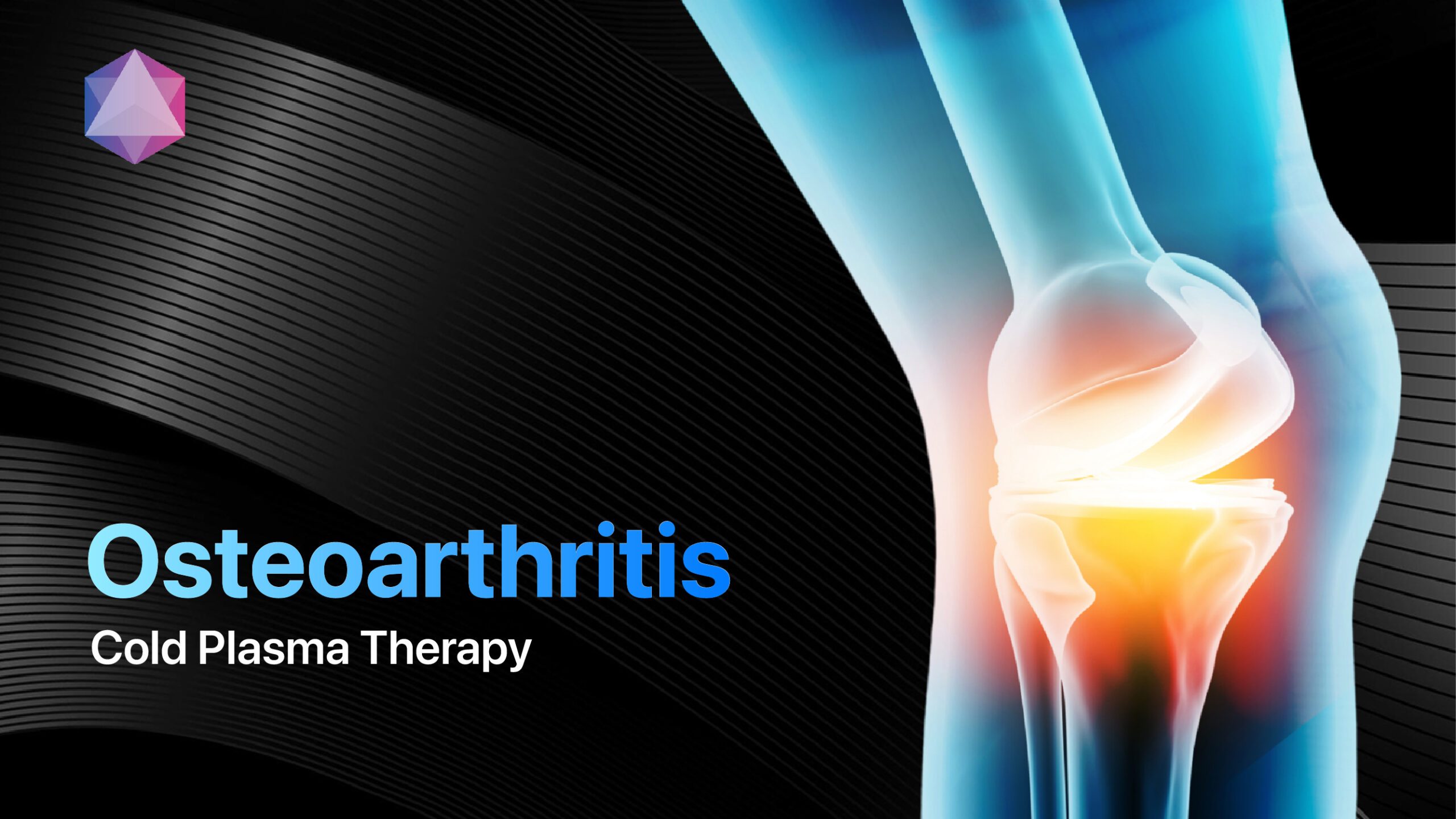
Did you know that over 32.5 million adults in the United States suffer from osteoarthritis, making it the most common form of arthritis?[1] This painful condition can significantly impact quality of life, causing stiffness, swelling, and reduced mobility in affected joints. But what if there was an innovative, non-invasive treatment that could provide long-lasting relief and help you regain your active lifestyle? Enter cold plasma therapy, a cutting-edge approach that is transforming osteoarthritis care. In this comprehensive article, we’ll explore what osteoarthritis is, its causes and symptoms, current treatment options, and how cold plasma therapy like the Mirari Cold Plasma System developed by General Vibronics is revolutionizing osteoarthritis management by harnessing the power of nitric oxide (NO).
1. What is Osteoarthritis?
Osteoarthritis is a degenerative joint disease that occurs when the protective cartilage cushioning the ends of your bones wears down over time. This can lead to pain, stiffness, and inflammation in the affected joints, making it challenging to perform daily activities and enjoy life to the fullest.[2]
Definition of Osteoarthritis
Osteoarthritis is characterized by the gradual breakdown of articular cartilage, the smooth, slippery tissue covering the ends of bones in a joint. As this cartilage deteriorates, the bones begin to rub against each other, causing pain, stiffness, and loss of movement. Osteoarthritis can affect any joint in the body but most commonly targets the hands, knees, hips, and spine.[3]

Osteoarthritis is a joint disease where cartilage wears down over time.
Prevalence in the United States
Osteoarthritis is incredibly prevalent, affecting over 32.5 million adults in the United States alone.[1] As the population ages, this number is expected to rise significantly. Nearly 50% of people over the age of 65 show symptoms of osteoarthritis in at least one joint, making it a major public health concern.[2]
Classification of Osteoarthritis
There are two main categories of osteoarthritis:
- Primary osteoarthritis: This type develops gradually with age and has no specific cause. It is related to the natural wear and tear of joints over time.
- Secondary osteoarthritis: This type is caused by an underlying condition or injury, such as obesity, joint trauma, or repetitive stress on a joint.[1]
Types of Osteoarthritis
Osteoarthritis can affect various joints in the body, leading to specific types of the condition:
- Hand osteoarthritis: Affects the joints in the fingers and the base of the thumb, causing pain, stiffness, and bony nodules called Heberden’s nodes.
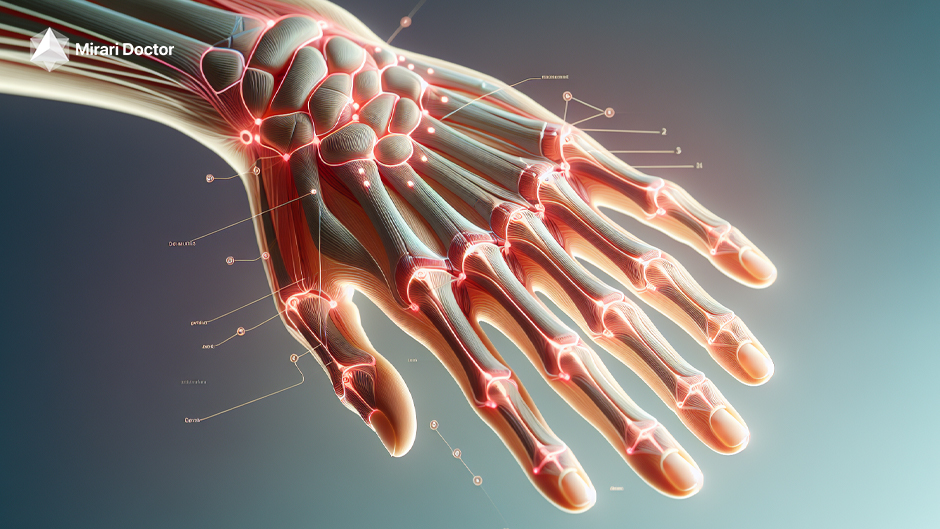
Hand osteoarthritis
- Knee osteoarthritis: Occurs in the knee joint, causing pain, stiffness, and difficulty moving the knee. It is one of the most common types of osteoarthritis.
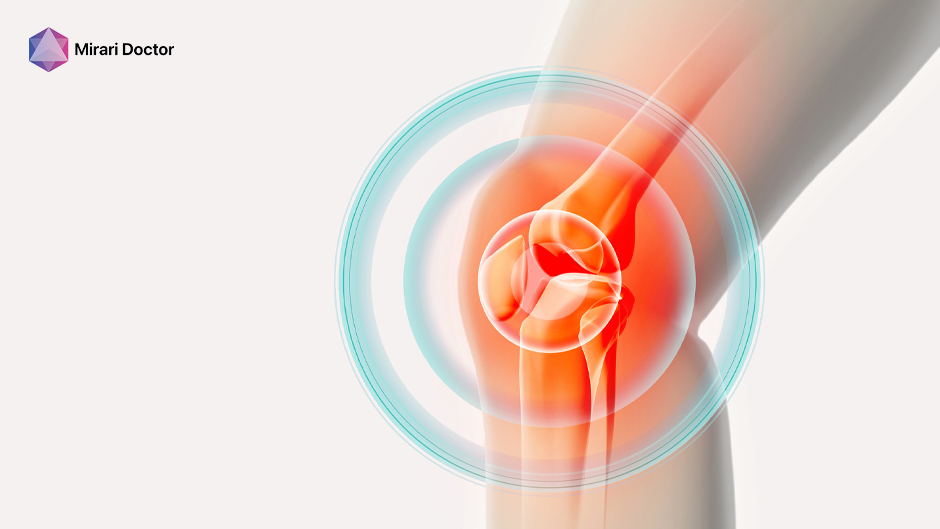
Knee osteoarthritis
- Hip osteoarthritis: Affects the hip joint, leading to pain in the groin, thigh, or buttocks, and making it difficult to walk, climb stairs, or perform daily activities.
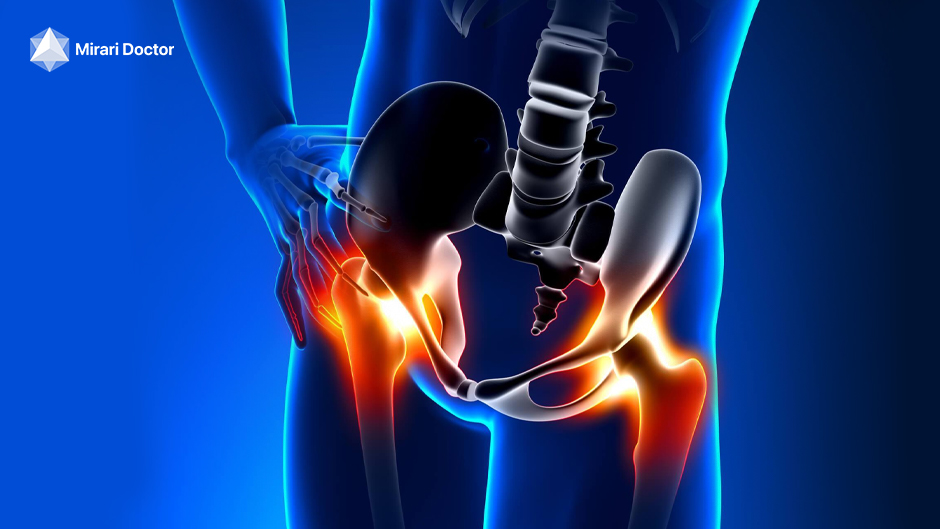
Hip osteoarthritis
- Spinal osteoarthritis: Develops in the joints of the spine, particularly in the neck and lower back, causing pain, stiffness, and reduced mobility.[1][3]
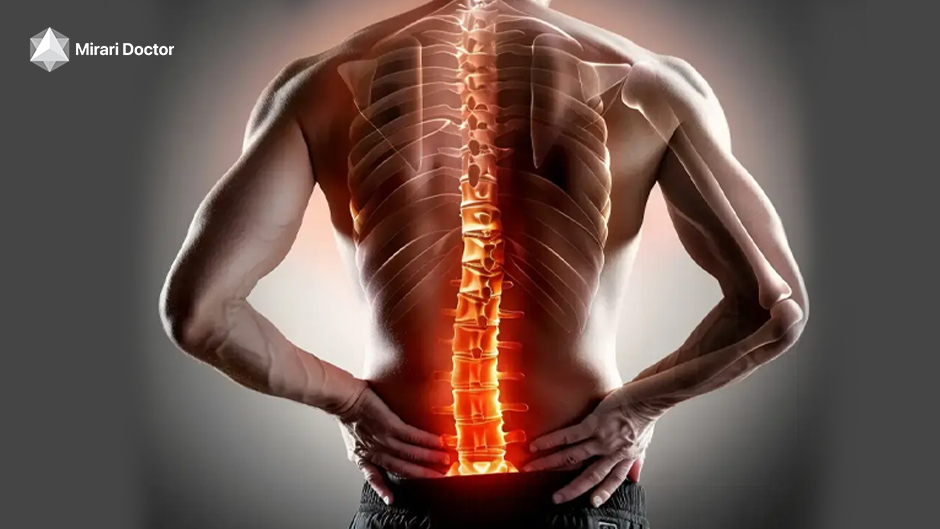
Spinal osteoarthritis
Symptoms of Osteoarthritis
The main symptoms of osteoarthritis include:
- Pain: A dull, aching pain in the affected joint that may worsen with activity and improve with rest.
- Stiffness: Difficulty moving the joint, especially after periods of inactivity or in the morning.
- Swelling: Inflammation and swelling around the affected joint.
- Crepitus: A grating or crackling sensation when moving the joint.
- Reduced range of motion: Difficulty moving the joint through its full range of motion.
- Bony enlargements: The formation of bony spurs or nodules around the affected joint.[1][2]
Symptoms can vary in severity and may come and go over time. As osteoarthritis progresses, the pain and stiffness can become more constant and interfere with daily life.
2. Causes and Risk Factors
While the exact cause of osteoarthritis is not fully understood, several factors can contribute to the development and progression of this condition.[1]
 |
Age and OsteoarthritisAge is the most significant risk factor for osteoarthritis. As you get older, the cartilage in your joints naturally begins to wear down, making you more susceptible to developing the condition. The risk of osteoarthritis increases significantly after age 50, with the majority of people over 65 showing some signs of the disease.[4] |
 |
Role of ObesityObesity plays a crucial role in the development and progression of osteoarthritis, particularly in weight-bearing joints like the knees and hips. Carrying excess weight puts additional stress on these joints, accelerating the breakdown of cartilage. Moreover, fat tissue produces inflammatory substances that can further damage joints. Losing weight can help reduce the risk of developing osteoarthritis and alleviate symptoms in those who already have the condition.[3] |
 |
Genetic FactorsGenetics may influence the development of osteoarthritis, especially in the hands and hips. Researchers have identified several genes that may increase the risk of osteoarthritis, but more studies are needed to fully understand the genetic basis of the disease. Having a family history of osteoarthritis can increase your likelihood of developing the condition.[5] |
 |
Joint Injuries and OveruseJoint injuries, such as those sustained during sports or accidents, can damage cartilage and increase the risk of osteoarthritis. Even if the injury heals, the joint may be more vulnerable to osteoarthritis in the future. Occupations or activities that involve repetitive stress on a particular joint can also contribute to the development of osteoarthritis over time.[1][6] |
 |
Other Contributing FactorsSeveral other factors may increase the risk of developing osteoarthritis, including:
Understanding these risk factors can help you take steps to prevent or manage osteoarthritis, such as maintaining a healthy weight, protecting your joints during physical activities, and strengthening the muscles around your joints.[6] |
3. Symptoms and Diagnosis
Recognizing the symptoms of osteoarthritis and receiving an accurate diagnosis are essential for effective management of the condition.[3]
Common Symptoms
The most common symptoms of osteoarthritis include:
- Pain: A dull, aching pain in the affected joint that may worsen with activity and improve with rest.
- Stiffness: Difficulty moving the joint, especially after periods of inactivity or in the morning.
- Swelling: Inflammation and swelling around the affected joint.
- Crepitus: A grating or crackling sensation when moving the joint.
- Reduced range of motion: Difficulty moving the joint through its full range of motion.
- Bony enlargements: The formation of bony spurs or nodules around the affected joint.[4]
These symptoms can vary in severity and may come and go over time. As osteoarthritis progresses, the pain and stiffness can become more constant and interfere with daily activities.[3]
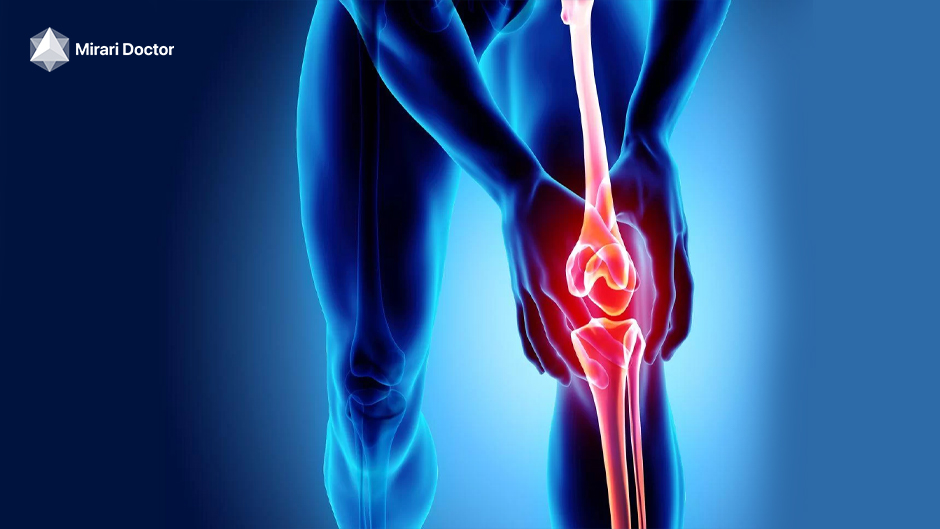
Osteoarthritis symptoms include joint pain, stiffness, swelling, crepitus, and reduced motion.
Diagnostic Procedures
To diagnose osteoarthritis, your healthcare provider will typically:
- Review your medical history: Your doctor will ask about your symptoms, risk factors, and any previous joint injuries or conditions.
- Perform a physical examination: Your doctor will check your affected joints for tenderness, swelling, redness, and range of motion.
- Order imaging tests: X-rays can reveal bone changes, cartilage loss, and the formation of bone spurs. In some cases, magnetic resonance imaging (MRI) or computed tomography (CT) scans may be used for a more detailed view of the joint.
- Analyze joint fluid: In certain situations, your doctor may remove a sample of fluid from the affected joint to check for inflammation and rule out other conditions, such as gout or infection.[7]

Analyze joint fluid
Self-Reported Symptoms
In addition to the objective findings from physical exams and imaging tests, your self-reported symptoms play a crucial role in the diagnosis and management of osteoarthritis. Your healthcare provider may ask you to describe:
- The location and intensity of your pain
- When your symptoms occur and how long they last
- What activities or factors seem to worsen or alleviate your symptoms
- How your symptoms affect your daily life and ability to perform tasks[5]
Keeping a symptom diary can help you track your symptoms over time and provide valuable information to your healthcare team.

Self-Reported Symptoms
Imaging Techniques
Imaging techniques, such as X-rays, MRI, and CT scans, are essential tools for diagnosing and monitoring the progression of osteoarthritis.
- X-rays: Plain X-rays can show joint space narrowing, bone changes, and the formation of bone spurs, which are characteristic signs of osteoarthritis. X-rays are often the first imaging test ordered when osteoarthritis is suspected.
- MRI: Magnetic resonance imaging provides a more detailed view of the soft tissues in and around the joint, including cartilage, ligaments, and menisci. MRI can detect early signs of osteoarthritis and help assess the extent of joint damage.
- CT scans: Computed tomography scans combine X-rays from different angles to create cross-sectional images of the joint. CT scans can provide a more detailed view of bone changes and can be useful for surgical planning.[8]
These imaging techniques, along with your reported symptoms and physical exam findings, help your healthcare provider make an accurate diagnosis and develop an appropriate treatment plan.
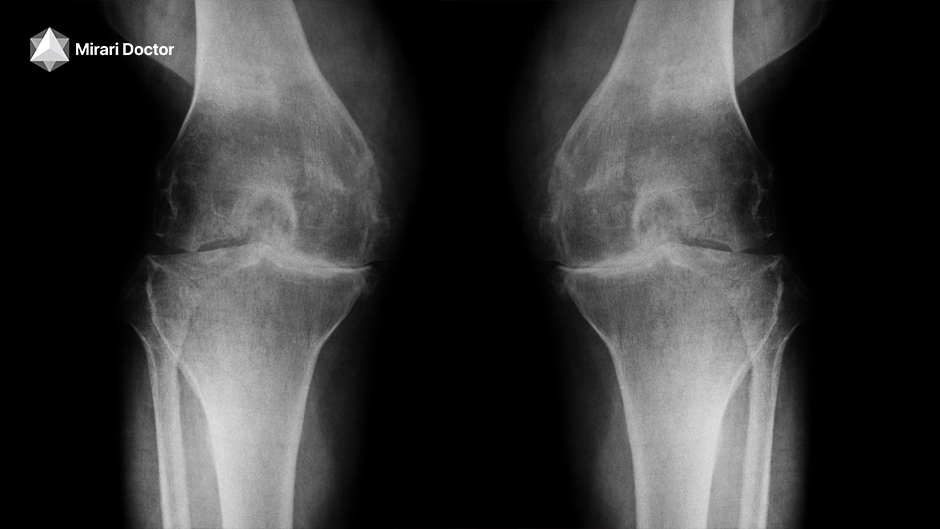
X-rays, MRI, and CT scans are crucial for diagnosing and monitoring osteoarthritis.
Differentiating Osteoarthritis from Other Conditions
It’s essential to differentiate osteoarthritis from other conditions that can cause similar symptoms, such as:
- Rheumatoid arthritis: An autoimmune disorder that causes inflammation and joint damage, often affecting the hands, wrists, and feet.
- Gout: A form of arthritis caused by the buildup of uric acid crystals in the joints, typically affecting the big toe.
- Psoriatic arthritis: A type of arthritis associated with the skin condition psoriasis, causing joint pain, stiffness, and swelling.
- Septic arthritis: A joint infection that can cause severe pain, swelling, and fever.[1]
Your healthcare provider will consider your symptoms, physical exam findings, imaging results, and laboratory tests to rule out these and other conditions and confirm a diagnosis of osteoarthritis.[7]
4. Treatment Options
While there is no cure for osteoarthritis, a variety of treatment options can help manage symptoms, improve joint function, and slow the progression of the disease.[5]
Non-Pharmacologic Therapies
Non-pharmacologic therapies are often the first line of treatment for osteoarthritis and can be used in combination with medications and other interventions.[9]
 |
Weight Loss and ExerciseWeight loss and exercise are two of the most important non-pharmacologic therapies for osteoarthritis, particularly for those with knee or hip osteoarthritis.[10]
Your healthcare provider or a physical therapist can help you develop a safe and effective weight loss and exercise plan tailored to your individual needs and abilities. |
 |
Physical TherapyPhysical therapy can be an essential component of osteoarthritis management, helping to:[11]
A physical therapist can develop a personalized treatment plan that may include exercises, manual therapy techniques, and the use of modalities such as heat, cold, or electrical stimulation. |
 |
Assistive Devices and OrthoticsAssistive devices and orthotics can help reduce joint stress, improve function, and alleviate pain in people with osteoarthritis.[9]
Your healthcare provider or a physical therapist can recommend appropriate assistive devices and orthotics based on your specific needs and the affected joints. |
Pharmacologic Treatments
Medications can play a significant role in managing osteoarthritis symptoms, reducing pain and inflammation, and improving joint function.[4]
 |
Topical TreatmentsTopical treatments, such as creams, gels, and patches, can provide localized pain relief for people with mild to moderate osteoarthritis.[4]
Topical treatments are generally well-tolerated and can be a good option for those who cannot take oral medications due to side effects or other health concerns. |
 |
Oral MedicationsOral medications can help manage pain and inflammation in people with osteoarthritis.[4]
Your healthcare provider will consider your individual needs, medical history, and potential side effects when recommending oral medications for osteoarthritis. |
 |
Joint InjectionsJoint injections can deliver medication directly to the affected joint, providing targeted pain relief and reduced inflammation.[4]
Your healthcare provider will determine if joint injections are appropriate for your specific case and will guide you through the process, including any potential risks and side effects. |
Emerging Therapies
As researchers continue to study osteoarthritis, new and promising therapies are emerging that may offer additional options for managing the condition.[12]
Stem Cell Therapy
Stem cell therapy involves injecting stem cells into the affected joint to promote cartilage repair and regeneration. While still considered an experimental treatment, some studies have shown promising results in reducing pain and improving function in people with osteoarthritis. However, more research is needed to establish the long-term safety and efficacy of this approach.[13]
Platelet-Rich Plasma (PRP) Injections
Platelet-rich plasma (PRP) injections involve using a concentrated sample of a person’s own blood platelets to promote healing in the affected joint. Some studies suggest that PRP injections may reduce pain and improve function in people with osteoarthritis, particularly in the knee joint. However, like stem cell therapy, more research is needed to fully understand the potential benefits and limitations of this treatment.
Cold Plasma Therapy
Cold plasma therapy is a cutting-edge treatment that is gaining attention for its potential to manage osteoarthritis symptoms and promote joint health. This non-invasive therapy uses a handheld device, such as the Mirari Cold Plasma System by Mirari Doctor and General Vibronics, to deliver a controlled stream of cold plasma to the affected joint.[14]
Mechanism of Action in Osteoarthritis
Cold plasma therapy works by harnessing the power of nitric oxide (NO), a molecule that plays a crucial role in many biological processes, including inflammation, pain signaling, and tissue repair. When applied to the skin, cold plasma triggers the production of nitric oxide, which can:[15]
- Reduce inflammation in the joint
- Modulate pain signaling pathways
- Stimulate the growth of new blood vessels
- Promote cartilage repair and regeneration
By targeting these key mechanisms, cold plasma therapy may offer a safe and effective way to manage osteoarthritis symptoms and slow the progression of the disease.
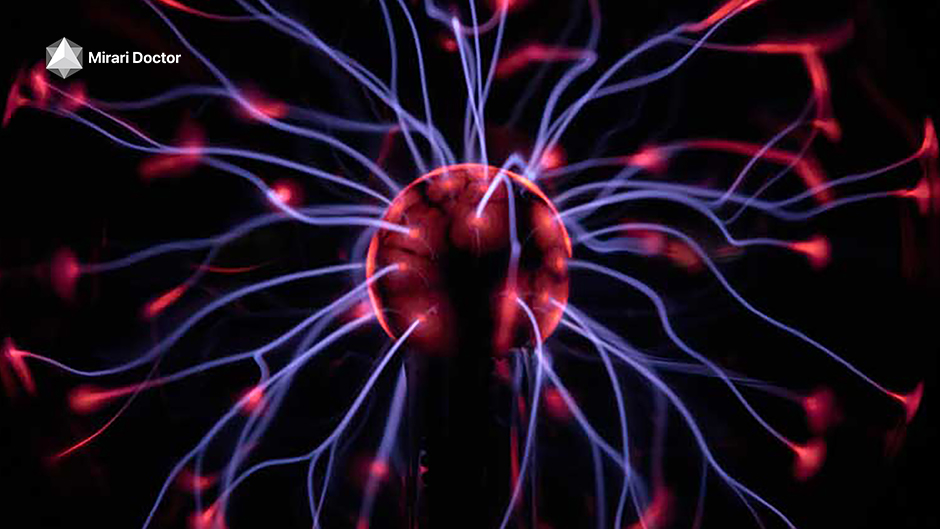
Cold plasma therapy is a new treatment for osteoarthritis symptoms.
Potential Benefits and Limitations
Cold plasma therapy offers several potential benefits for people with osteoarthritis, including:[16]
- Non-invasive and painless application
- Localized treatment with minimal systemic side effects
- Rapid symptom relief
- Potential for long-term joint health benefits
However, as with any emerging therapy, there are limitations and unknowns that require further research:
- Long-term efficacy and safety data are still limited
- Optimal treatment protocols and dosing schedules need to be established
- The therapy may not be suitable for all individuals with osteoarthritis
As more studies are conducted, the full potential and limitations of cold plasma therapy for osteoarthritis will become clearer.
Current Research and Future Directions
Recent studies have shown promising results for the use of cold plasma therapy in managing osteoarthritis symptoms and promoting joint health. For example:
- A randomized controlled trial found that cold plasma therapy significantly reduced pain and improved function in people with knee osteoarthritis compared to a placebo treatment.[17]
- An in vitro study demonstrated that cold plasma exposure could stimulate the growth and differentiation of cartilage cells, suggesting a potential for cartilage regeneration.[19]
As research continues, scientists and healthcare providers are working to:
- Optimize treatment protocols and dosing schedules for maximum efficacy and safety
- Investigate the potential of combining cold plasma therapy with other treatments, such as physical therapy or medications
- Explore the use of cold plasma therapy for other joint conditions, such as rheumatoid arthritis or sports injuries
With ongoing advancements in cold plasma technology, devices like the Mirari Cold Plasma System may become increasingly accessible and widely used for managing osteoarthritis and promoting joint health.[20]

Cold plasma advancements may make devices like Mirari more accessible for osteoarthritis.
Surgical Options
In some cases, when conservative treatments fail to provide adequate relief or joint damage is severe, surgery may be necessary to manage osteoarthritis.[6]
When is Surgery Necessary?
Your healthcare provider may recommend surgery for osteoarthritis if:
- Pain and stiffness are severe and significantly impact your quality of life
- Other treatments, such as medications, physical therapy, and injections, have not provided sufficient relief
- Joint damage is extensive, and the joint is no longer functioning properly[4]
The decision to undergo surgery should be made in consultation with your healthcare provider, taking into account your individual needs, goals, and potential risks and benefits.
Types of Surgical Procedures
Several surgical options are available for managing osteoarthritis, depending on the affected joint and the extent of the damage.[3]
- Arthroscopy: A minimally invasive procedure that uses a small camera and instruments to remove damaged cartilage, repair torn menisci, or smooth out rough joint surfaces. Arthroscopy is most commonly used for knee and shoulder osteoarthritis.[21]
- Osteotomy: A procedure that involves cutting and realigning bones to shift weight away from the damaged part of the joint. Osteotomy is most often used for knee osteoarthritis in younger, active individuals.[22]
- Joint replacement: A procedure that involves removing the damaged joint surfaces and replacing them with artificial components made of metal, plastic, or ceramic. Joint replacement is most commonly performed for hip and knee osteoarthritis when other treatments have failed.[23]
Your orthopedic surgeon will discuss the most appropriate surgical option for your specific case, including the expected outcomes, risks, and recovery process.
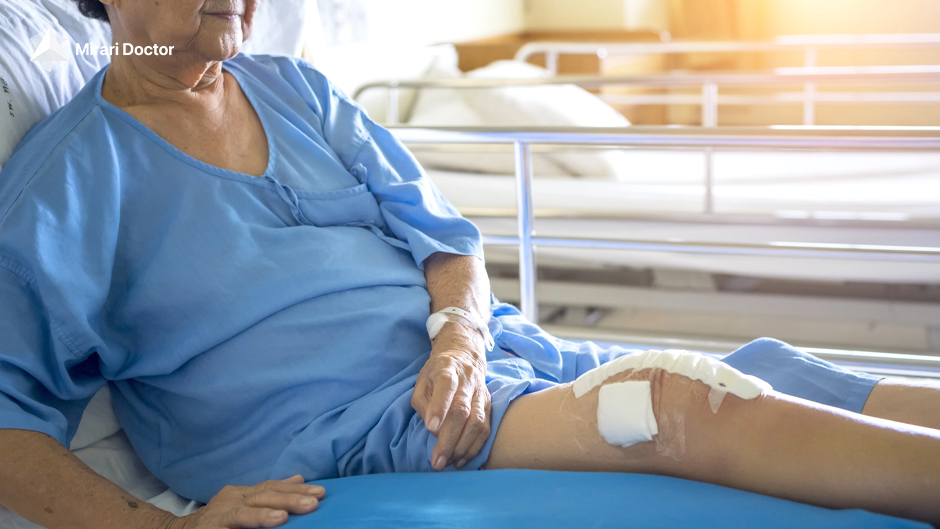
Joint replacement swaps damaged joints with artificial ones, often for severe hip or knee osteoarthritis.
Post-Surgery Rehabilitation
After surgery for osteoarthritis, rehabilitation is crucial to help you regain joint function, strength, and mobility. Your post-surgery rehabilitation plan may include:[24]
- Pain management: Medications and other techniques to control pain and swelling after surgery.
- Physical therapy: Exercises and manual therapy techniques to improve range of motion, strength, and function.
- Occupational therapy: Training in activities of daily living and the use of assistive devices to help you regain independence.
- Gradual return to activities: A progressive plan to help you safely resume your normal activities and hobbies.
Your healthcare team will work with you to develop a personalized rehabilitation plan and guide you through the recovery process, ensuring the best possible outcomes after surgery for osteoarthritis.

Physical therapy enhances joint motion, strength, and function.
5. Living with Osteoarthritis
Living with osteoarthritis can be challenging, but there are many strategies and resources available to help you manage your symptoms, maintain your quality of life, and cope with the emotional impact of the condition.[3]
 |
Coping StrategiesCoping with osteoarthritis involves a combination of physical, emotional, and social strategies to help you manage pain, maintain function, and adapt to any limitations.[25]
Remember, coping with osteoarthritis is an ongoing process, and what works for one person may not work for another. Be patient with yourself and don’t hesitate to seek help from your healthcare team or a mental health professional if you need additional support. |
 |
Lifestyle ModificationsMaking lifestyle changes can help you manage your osteoarthritis symptoms, slow the progression of the disease, and improve your overall health and well-being.[9]
|
 |
Support and Education ResourcesHaving access to reliable information and support is essential for living well with osteoarthritis. Several resources are available to help you learn more about the condition, stay up-to-date on treatment options, and connect with others who understand what you’re going through.[5]
In addition to these national resources, your local healthcare providers, community organizations, and support groups can provide valuable information, guidance, and emotional support as you navigate life with osteoarthritis. |
 |
Community Programs and Support GroupsConnecting with others who have osteoarthritis can provide a sense of community, reduce feelings of isolation, and offer practical tips and emotional support for managing the condition.[26]
Participating in community programs and support groups can be a valuable addition to your osteoarthritis management plan, providing both practical and emotional benefits as you navigate life with the condition. |
 |
Tracking Progress and Managing PainMonitoring your symptoms, tracking your progress, and having a plan for managing pain are important aspects of living with osteoarthritis.[28]
By actively tracking your progress and working with your healthcare team to manage your pain, you can take a proactive role in your osteoarthritis care and maintain the best possible quality of life. |
Incorporating Cold Plasma Therapy in Daily Management
As an emerging treatment option, cold plasma therapy can be incorporated into your daily osteoarthritis management routine to help control pain, reduce inflammation, and promote joint health.[15]
Devices like the Mirari Cold Plasma System by Mirari Doctor and General Vibronics offer a convenient, non-invasive way to administer cold plasma therapy at home. By using the device regularly, as directed by your healthcare provider, you may experience:
- Reduced pain and stiffness in the affected joints
- Improved joint function and range of motion
- Decreased inflammation and swelling
- Potential long-term benefits for joint health and cartilage regeneration
Incorporating cold plasma therapy into your daily routine, along with other lifestyle modifications and treatment options, can help you take a proactive approach to managing your osteoarthritis and maintaining your quality of life.

The Mirari Cold Plasma System offers a convenient home treatment for joint pain, stiffness, and inflammation.
6. Future Directions in Osteoarthritis Research
As scientists continue to study osteoarthritis, new insights into the underlying mechanisms of the disease and innovative treatment approaches are emerging, offering hope for better management and potentially even prevention of this common condition[29].
Advancements in Understanding Osteoarthritis Pathophysiology
Recent research has shed new light on the complex processes involved in the development and progression of osteoarthritis, moving beyond the traditional view of the disease as simply “wear and tear” of the joints[30][31].
- Inflammation: Studies have revealed that inflammation plays a key role in osteoarthritis, contributing to cartilage breakdown, pain, and other symptoms. Understanding the inflammatory pathways involved may lead to new therapeutic targets and interventions[31].
- Metabolic factors: Research has identified links between osteoarthritis and metabolic disorders, such as obesity and diabetes. Investigating these connections may provide insights into the systemic factors that contribute to joint damage and inform new preventive strategies[31].
- Biomechanical factors: Advances in biomechanical research, including the use of sophisticated imaging techniques and computer modeling, are helping scientists better understand the mechanical forces and stresses that contribute to osteoarthritis development and progression[30].
As our understanding of osteoarthritis pathophysiology continues to grow, new avenues for prevention, early intervention, and targeted therapies are likely to emerge[29].

Advances in osteoarthritis research will bring new prevention and treatment options.
Innovations in Diagnostic Tools and Biomarkers
Early and accurate diagnosis of osteoarthritis is essential for timely intervention and optimal management of the condition. Researchers are working to develop new diagnostic tools and biomarkers that can detect osteoarthritis in its earliest stages and monitor disease progression over time[32][33].
- Imaging techniques: Advanced imaging methods, such as high-resolution MRI and ultrasound, are being refined to provide more detailed views of joint structures and detect subtle changes associated with early osteoarthritis[30].
- Biochemical markers: Scientists are identifying and validating biochemical markers in blood, urine, and synovial fluid that may indicate the presence and progression of osteoarthritis. These biomarkers could be used to diagnose the disease, monitor treatment response, and predict outcomes[33].
- Genetic markers: Research is ongoing to identify genetic factors that may increase the risk of developing osteoarthritis or influence its progression. Genetic markers could be used to screen for individuals at higher risk and tailor prevention and treatment strategies accordingly[32].
As these diagnostic tools and biomarkers are refined and validated, they may become valuable additions to the clinical management of osteoarthritis, enabling earlier intervention and more personalized care[32][33].

Innovations in Diagnostic Tools and Biomarkers
Novel Therapeutic Targets and Drug Development
With a growing understanding of the molecular and cellular mechanisms involved in osteoarthritis, researchers are identifying new therapeutic targets and developing innovative drugs to modify the course of the disease[29].
- Anti-inflammatory agents: Given the central role of inflammation in osteoarthritis, new anti-inflammatory drugs are being developed to target specific inflammatory pathways and reduce joint damage. These may include small molecules, biologics, or gene therapies[29][30].
- Cartilage regeneration: Researchers are exploring ways to stimulate cartilage repair and regeneration, such as using growth factors, stem cells, or biomaterials to promote the growth of new, healthy cartilage tissue[30].
- Pain modulation: Novel approaches to pain management, such as targeting specific pain receptors or using neuromodulation techniques, are being investigated to provide more effective and targeted relief for osteoarthritis pain[29].

Understanding osteoarthritis mechanisms helps researchers find new drug targets and treatments.
Potential of Cold Plasma Therapy in Osteoarthritis Treatment
Cold plasma therapy, an emerging non-invasive treatment, holds significant promise as a novel therapeutic approach for osteoarthritis. By harnessing the power of nitric oxide (NO) and other bioactive molecules, cold plasma therapy may offer a safe and effective way to modulate inflammation, promote cartilage health, and alleviate pain[34].
Research suggests that cold plasma therapy, delivered through devices like the Mirari Cold Plasma System by Mirari Doctor and General Vibronics, may:
- Reduce inflammation in the joint by modulating inflammatory signaling pathways[34]
- Stimulate the growth and differentiation of cartilage cells, potentially promoting cartilage regeneration[34]
- Modulate pain signaling and provide rapid pain relief[34]
- Improve joint function and range of motion[34]
As more studies investigate the mechanisms and clinical applications of cold plasma therapy in osteoarthritis, this innovative approach may become an increasingly important tool in the management of the condition, offering new hope for patients seeking safe, effective, and non-invasive treatment options[34].
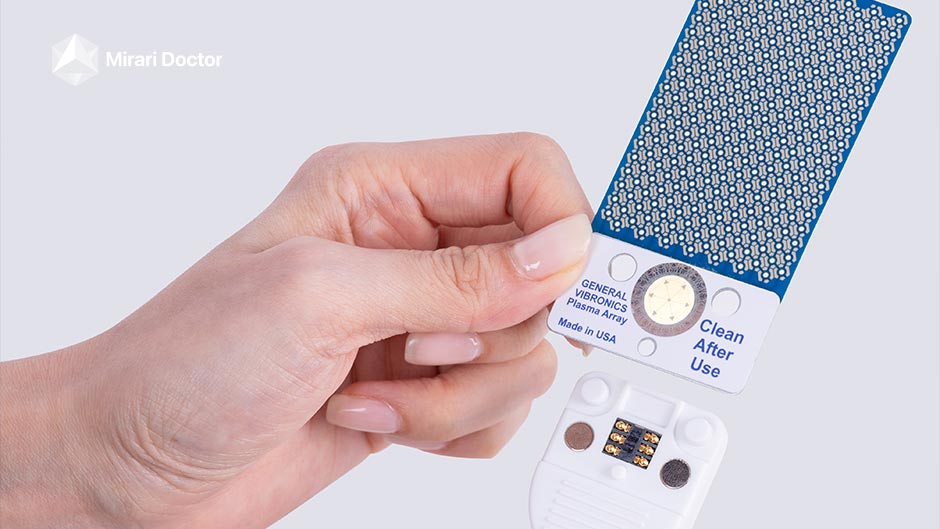
Cold plasma therapy may effectively treat osteoarthritis by reducing inflammation and pain.
Personalized Medicine Approaches
Personalized medicine, also known as precision medicine, is an emerging approach that tailors prevention, diagnosis, and treatment strategies to an individual’s unique genetic, biochemical, and lifestyle factors. In the context of osteoarthritis, personalized medicine may involve[35][32]:
- Genetic profiling: Using genetic information to identify individuals at higher risk of developing osteoarthritis or experiencing more rapid disease progression, allowing for targeted prevention and early intervention strategies[35].
- Biomarker-guided treatment: Utilizing biochemical markers to predict an individual’s response to specific treatments, such as medications or cold plasma therapy, enabling healthcare providers to select the most appropriate interventions for each patient[35][32].
- Lifestyle interventions: Developing personalized exercise, nutrition, and weight management plans based on an individual’s specific needs, preferences, and osteoarthritis subtype[35].
By embracing personalized medicine approaches, healthcare providers may be able to optimize osteoarthritis prevention and treatment, improving outcomes and quality of life for patients with this common and debilitating condition[35][32].

Personalized medicine tailors prevention, diagnosis, and treatment to individual genetic, biochemical, and lifestyle factors.
Strategies for Prevention and Early Intervention
As the old adage goes, “an ounce of prevention is worth a pound of cure.” In the case of osteoarthritis, preventing or delaying the onset of the disease and intervening early in its course may have significant benefits for individuals and society as a whole[29].
Research is focusing on identifying effective strategies for osteoarthritis prevention and early intervention, such as:
- Lifestyle modifications: Encouraging healthy lifestyle habits, such as maintaining a normal body weight, engaging in regular low-impact exercise, and eating a balanced diet rich in nutrients that support joint health, may help prevent or delay the development of osteoarthritis[29][30].
- Injury prevention: Implementing programs to reduce the risk of joint injuries, particularly in high-risk populations such as athletes or those in physically demanding occupations, may help prevent post-traumatic osteoarthritis[30].
- Early detection and intervention: Utilizing advanced diagnostic tools and biomarkers to identify individuals with early signs of osteoarthritis, and implementing prompt, targeted interventions, such as cold plasma therapy or other emerging treatments, may slow disease progression and improve long-term outcomes[29][34][35].
As research continues to uncover new insights into the risk factors, mechanisms, and early stages of osteoarthritis, more effective prevention and early intervention strategies are likely to emerge, offering hope for reducing the global burden of this prevalent and disabling condition[29][30].

Healthy habits can help prevent or delay osteoarthritis.
7. Takeaways
- Osteoarthritis is a common, degenerative joint disease that affects millions of people worldwide, causing pain, stiffness, and reduced mobility[1].
- While there is no cure for osteoarthritis, a range of treatment options, including medications, physical therapy, injections, and emerging therapies like cold plasma therapy, can help manage symptoms and improve joint function[1][32].
- Cold plasma therapy, delivered through devices like the Mirari Cold Plasma System by Mirari Doctor and General Vibronics, is a promising non-invasive treatment that harnesses the power of nitric oxide (NO) to reduce inflammation, alleviate pain, and potentially promote cartilage regeneration[34].
- Lifestyle modifications, such as maintaining a healthy weight, exercising regularly, and protecting your joints, can play a significant role in managing osteoarthritis and improving overall quality of life[1][3].
- Support and education resources, including the Arthritis Foundation, NIAMS, and local community programs, can provide valuable information and emotional support for people living with osteoarthritis[5].
- Ongoing research is advancing our understanding of osteoarthritis pathophysiology, leading to the development of new diagnostic tools, biomarkers, and targeted therapies, such as cold plasma therapy, that may revolutionize the prevention and management of this condition in the future[32][34].
8. FAQs
What is osteoarthritis, and what are its main symptoms?
Osteoarthritis is a degenerative joint disease characterized by the breakdown of cartilage, leading to pain, stiffness, swelling, and reduced mobility in the affected joints. The most common symptoms include joint pain, stiffness, crepitus (a grating or crackling sensation), and reduced range of motion[1].
How is cold plasma therapy different from other osteoarthritis treatments?
Cold plasma therapy is a non-invasive, drug-free treatment that uses a handheld device to deliver a controlled stream of cold plasma to the affected joint. Unlike medications or injections, cold plasma therapy harnesses the power of nitric oxide (NO) to reduce inflammation, alleviate pain, and potentially promote cartilage regeneration without the risk of systemic side effects[34].
Is cold plasma therapy safe, and what are the potential side effects?
Cold plasma therapy, delivered through devices like the Mirari Cold Plasma System, is generally considered safe, with minimal risk of side effects. Some people may experience temporary, mild skin irritation at the treatment site. However, as with any new treatment, it is essential to consult with a healthcare provider to determine if cold plasma therapy is appropriate for your specific case[34].
How can I incorporate cold plasma therapy into my daily osteoarthritis management routine?
If you and your healthcare provider determine that cold plasma therapy is right for you, devices like the Mirari Cold Plasma System by Mirari Doctor and General Vibronics offer a convenient way to administer the treatment at home. Follow the device instructions and your healthcare provider’s guidance on treatment frequency and duration to incorporate cold plasma therapy into your daily routine alongside other management strategies like exercise and joint protection[34].
What lifestyle changes can I make to help manage my osteoarthritis symptoms?
Lifestyle modifications can play a significant role in managing osteoarthritis symptoms and improving overall joint health. Some key changes include maintaining a healthy weight, engaging in regular low-impact exercise, eating a balanced diet rich in nutrients that support joint health, and using proper body mechanics and assistive devices to reduce stress on your joints. Consult with your healthcare provider or a physical therapist to develop a personalized plan that meets your specific needs and goals[1][3].
9. References
- Centers for Disease Control and Prevention. (2023). Osteoarthritis (OA). https://www.cdc.gov/arthritis/basics/osteoarthritis.htm
- Cleveland Clinic. (2023). Osteoarthritis: Symptoms, Causes & Treatment Options. https://my.clevelandclinic.org/health/diseases/5599-osteoarthritis
- Arthritis Foundation. (n.d.). Osteoarthritis. https://www.arthritis.org/diseases/osteoarthritis
- Mayo Clinic. (2021). Osteoarthritis. https://www.mayoclinic.org/diseases-conditions/osteoarthritis/symptoms-causes/syc-20351925
- National Institute of Arthritis and Musculoskeletal and Skin Diseases. (2019). Osteoarthritis. https://www.niams.nih.gov/health-topics/osteoarthritis
- American Academy of Orthopaedic Surgeons. (2021). Osteoarthritis. https://orthoinfo.aaos.org/en/diseases–conditions/osteoarthritis/
- American College of Rheumatology. (2021). Osteoarthritis. https://www.rheumatology.org/I-Am-A/Patient-Caregiver/Diseases-Conditions/Osteoarthritis
- Radiological Society of North America. (2021). Osteoarthritis. https://www.radiologyinfo.org/en/info/arthritis
- Kolasinski, S. L., Neogi, T., Hochberg, M. C., Oatis, C., Guyatt, G., Block, J., … & Reston, J. (2020). 2019 American College of Rheumatology/Arthritis Foundation guideline for the management of osteoarthritis of the hand, hip, and knee. Arthritis & Rheumatology, 72(2), 220-233. https://www.rheumatology.org/osteoarthritis-guideline
- Fernandes, L., Hagen, K. B., Bijlsma, J. W., Andreassen, O., Christensen, P., Conaghan, P. G., … & Vliet Vlieland, T. P. (2013). EULAR recommendations for the non-pharmacological core management of hip and knee osteoarthritis. Annals of the rheumatic diseases, 72(7), 1125-1135. https://pubmed.ncbi.nlm.nih.gov/20129203/
- Bennell, K. L., & Hinman, R. S. (2011). A review of the clinical evidence for exercise in osteoarthritis of the hip and knee. Journal of Science and Medicine in Sport, 14(1), 4-9. https://pubmed.ncbi.nlm.nih.gov/20129203/
- Arden, N. K., Perry, T. A., Bannuru, R. R., Bruyère, O., Cooper, C., Haugen, I. K., … & Reginster, J. Y. (2021). Non-surgical management of knee osteoarthritis: comparison of ESCEO and OARSI 2019 guidelines. Nature Reviews Rheumatology, 17(1), 59-66. https://www.nature.com/articles/s41584-020-00523-9
- Pas, H. I., Winters, M., Haisma, H. J., Koenis, M. J., Tol, J. L., & Moen, M. H. (2017). Stem cell injections in knee osteoarthritis: a systematic review of the literature. British journal of sports medicine, 51(15), 1125-1133. https://bjsm.bmj.com/content/51/15/1125
- Dai, W. L., Zhou, A. G., Zhang, H., & Zhang, J. (2017). Efficacy of platelet-rich plasma in the treatment of knee osteoarthritis: a meta-analysis of randomized controlled trials. Arthroscopy: The Journal of Arthroscopic & Related Surgery, 33(3), 659-670. https://www.arthroscopyjournal.org/article/S0749-8063(16)30780-0/fulltext
- Bekeschus, S., Favia, P., Robert, E., & von Woedtke, T. (2019). White paper on plasma for medicine and hygiene: Future in plasma health sciences. Plasma Processes and Polymers, 16(1), 1800033. https://onlinelibrary.wiley.com/doi/full/10.1002/ppap.201800033
- Graves, D. B. (2014). The emerging role of reactive oxygen and nitrogen species in redox biology and some implications for plasma applications to medicine and biology. Journal of Physics D: Applied Physics, 45(26), 263001. https://iopscience.iop.org/article/10.1088/0022-3727/45/26/263001
- Bekeschus, S., Schmidt, A., Weltmann, K. D., & von Woedtke, T. (2016). The plasma jet kINPen–a powerful tool for wound healing. Clinical Plasma Medicine, 4(1), 19-28. https://www.sciencedirect.com/science/article/pii/S2212816616300099
- Brehmer, F., Haenssle, H. A., Daeschlein, G., Ahmed, R., Pfeiffer, S., Görlitz, A., … & Emmert, S. (2015). Alleviation of chronic venous leg ulcers with a hand-held dielectric barrier discharge plasma generator (PlasmaDerm® VU-2010): results of a monocentric, two-armed, open, prospective, randomized and controlled trial (NCT01415622). Journal of the European Academy of Dermatology and Venereology, 29(1), 148-155. https://onlinelibrary.wiley.com/doi/full/10.1111/jdv.12490
- Wiegand, C., Fink, S., Beier, O., Horn, K., Pfuch, A., Schimanski, A., … & Hipler, U. C. (2016). Cold atmospheric pressure plasmas exhibit antimicrobial and anti-inflammatory properties against Propionibacterium acnes in vitro. Experimental Dermatology, 25(1), 62-63. https://onlinelibrary.wiley.com/doi/full/10.1111/exd.12885
- Keidar, M., Shashurin, A., Volotskova, O., Ann Stepp, M., Srinivasan, P., Sandler, A., & Trink, B. (2013). Cold atmospheric plasma in cancer therapy. Physics of Plasmas, 20(5), 057101. https://aip.scitation.org/doi/full/10.1063/1.4801516
- Siemieniuk, R. A., Harris, I. A., Agoritsas, T., Poolman, R. W., Brignardello-Petersen, R., Van de Velde, S., … & Kristiansen, A. (2017). Arthroscopic surgery for degenerative knee arthritis and meniscal tears: a clinical practice guideline. BMJ, 357, j1982. https://www.bmj.com/content/357/bmj.j1982
- Brouwer, R. W., Huizinga, M. R., Duivenvoorden, T., van Raaij, T. M., Verhagen, A. P., Bierma-Zeinstra, S. M., & Verhaar, J. A. (2014). Osteotomy for treating knee osteoarthritis. Cochrane Database of Systematic Reviews, (12). https://www.cochranelibrary.com/cdsr/doi/10.1002/14651858.CD004019.pub4/full
- Skou, S. T., Roos, E. M., Laursen, M. B., Rathleff, M. S., Arendt-Nielsen, L., Simonsen, O., & Rasmussen, S. (2015). A randomized, controlled trial of total knee replacement. New England Journal of Medicine, 373(17), 1597-1606. https://www.nejm.org/doi/full/10.1056/nejmoa1505467
- Artz, N., Elvers, K. T., Lowe, C. M., Sackley, C., Jepson, P., & Beswick, A. D. (2015). Effectiveness of physiotherapy exercise following total knee replacement: systematic review and meta-analysis. BMC musculoskeletal disorders, 16(1), 1-21. https://bmcmusculoskeletdisord.biomedcentral.com/articles/10.1186/s12891-015-0469-6
- Geenen, R., Overman, C. L., Christensen, R., Åsenlöf, P., Capela, S., Huisinga, K. L., … & Vlaeyen, J. W. (2018). EULAR recommendations for the health professional’s approach to pain management in inflammatory arthritis and osteoarthritis. Annals of the rheumatic diseases, 77(6), 797-807. https://ard.bmj.com/content/77/6/797
- Damush, T. M., Perkins, S. M., Mikesky, A. E., Roberts, M., & O’Dea, J. (2005). Motivational factors influencing older adults diagnosed with knee osteoarthritis to join and maintain an exercise program. Journal of Aging and Physical Activity, 13(1), 45-60. https://journals.humankinetics.com/view/journals/japa/13/1/article-p45.xml
- Callahan, L. F., Mielenz, T., Freburger, J., Shreffler, J., Hootman, J., Brady, T., … & Schwartz, T. (2008). A randomized controlled trial of the people with arthritis can exercise program: symptoms, function, physical activity, and psychosocial outcomes. Arthritis Care & Research, 59(1), 92-101. https://onlinelibrary.wiley.com/doi/full/10.1002/art.23239
- Hawker, G. A., Mian, S., Kendzerska, T., & French, M. (2011). Measures of adult pain: Visual analog scale for pain (VAS pain), numeric rating scale for pain (NRS pain), McGill pain questionnaire (MPQ), short‐form McGill pain questionnaire (SF‐MPQ), chronic pain grade scale (CPGS), short form‐36 bodily pain scale (SF‐36 BPS), and measure of intermittent and constant osteoarthritis pain (ICOAP). Arthritis Care & Research, 63(S11), S240-S252. https://onlinelibrary.wiley.com/doi/full/10.1002/acr.20543
- Sofat, N., & Kuttapitiya, A. (2014). Future directions for the management of pain in osteoarthritis. International Journal of Clinical Rheumatology, 9(2), 197-276. https://www.ncbi.nlm.nih.gov/pmc/articles/PMC4089899/
- Kittelson, A. J., George, S. Z., Maluf, K. S., & Stevens-Lapsley, J. E. (2014). Future Directions in Painful Knee Osteoarthritis: Harnessing Complexity in a Heterogeneous Population. Physical Therapy, 94(3), 422-432. https://www.ncbi.nlm.nih.gov/pmc/articles/PMC3967122/
- Coaccioli, S., Sarzi-Puttini, P., Zis, P., Rinonapoli, G., & Varrassi, G. (2022). Osteoarthritis: New Insight on Its Pathophysiology. Journal of Clinical Medicine, 11(20), 6155. https://www.ncbi.nlm.nih.gov/pmc/articles/PMC9604603/
- Mobasheri, A., Thudium, C. S., Bay-Jensen, A. C., Maleitzke, T., Geissler, S., Duda, G. N., & Winkler, T. (2023). Biomarkers for osteoarthritis: Current status and future prospects. Best Practice & Research Clinical Rheumatology, 37(3), 101788. https://www.sciencedirect.com/science/article/pii/S1521694223000384
- Jiang, Y., Guo, Y., Ren, Y., Hou, Y., Li, X., & Wang, Y. (2021). Emerging Technologies and Platforms for the Immunodetection of Multiple Biochemical Markers in Osteoarthritis Research and Therapy. Frontiers in Medicine, 7, 572977. https://www.frontiersin.org/journals/medicine/articles/10.3389/fmed.2020.572977/full
- Ding, C., Ni, L., Liu, Q., Zhou, C., Wang, G., Chu, P. K., & Wu, Z. (2023). Cold air plasma improving rheumatoid arthritis via mitochondrial apoptosis pathway. Bioengineering & Translational Medicine, 8(1), e10366. https://www.ncbi.nlm.nih.gov/pmc/articles/PMC9842019/
- Sawitzke, A. D. (2013). Personalized medicine for osteoarthritis: where are we now? Therapeutic Advances in Musculoskeletal Disease, 5(2), 67-75. https://www.ncbi.nlm.nih.gov/pmc/articles/PMC3638314/
Related articles
Made in USA


